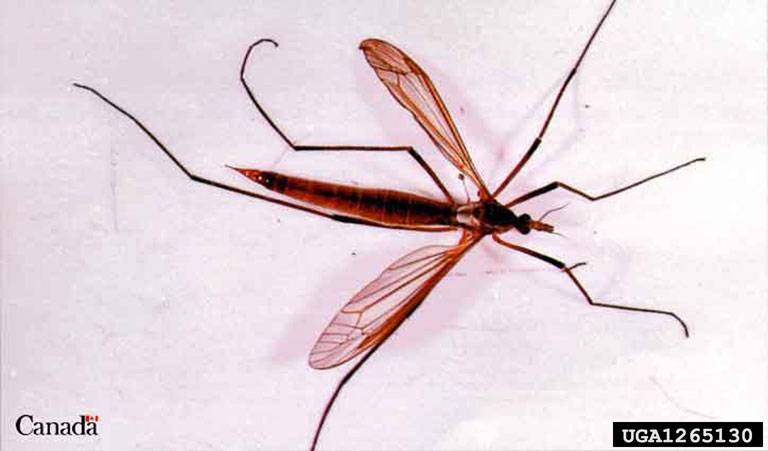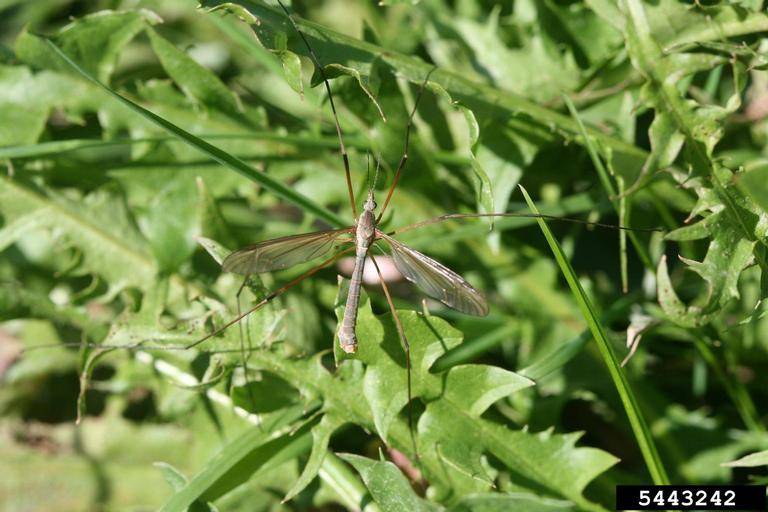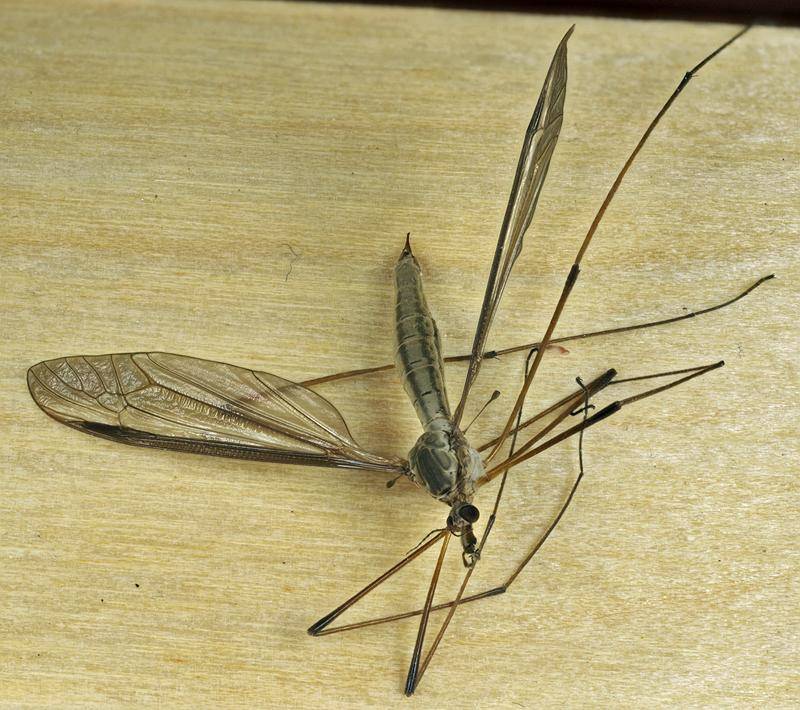Origin │ Habitat │ Introduction and Spread │ Impacts │ Identification │ Prevention and Control │ NY Occurrences │ Other Occurrences
Background
European crane flies (Tipula paludosa), also known as leather jackets during the larval stage, are an invasive insect that have become established in the northwestern United States, eastern Canada, and New York. Crane flies look like large mosquitoes, but exploit a different ecological niche and do not bite humans. Crane flies are most problematic to the turf grass industry, especially on golf courses. This is because the flies lay their eggs in the soil for larvae to feed. Tipula paludosa as well as Tipula oleracea are exotic European crane flies that are present in New York.

Origin
European crane flies (T. paludosa) are native to northwestern Europe.
Habitat
European crane flies thrive in moist soils and prefer mild winters and cool summers. In Quebec, Canada, T. paludosa had higher larval abundance in silt or clay soils rather than sandy soils (Taschereau et al. 2009). They have been found in many different types of turf grass (at homes and golf courses), sod farms, and grass fields. The flies also favor areas with thatch buildup.
Introduction and Spread
European crane flies were most likely introduced through the transport of infested materials. During the summer months, T. paludosa larvae will reside below the soil surface and pupate. By end of August or early September, the adults emerge, mate, and lay 200-300 eggs within 24 hours. Once the eggs hatch, the larvae will feed throughout the fall and spring. T. paludosa complete one generation per year and T. oleracea will complete two generations per year with adults emerging in the spring in addition to the fall. T. oleracea females are better fliers, which could contribute to their eggs being more dispersed than T. paludosa eggs (Peck 2006).
Impacts
European crane flies have a large impact on the turf grass industry. The larvae may scalp lawns during foliar feeding and damage the root systems as well. Dawson et al. (2004) found that larvae of crane flies significantly impact shoot and root biomass and the microbial composition of the soil. Damaged lawns may appear yellow or have bare spots. Crane fly larvae have the potential to affect cereals and produce crops, nursery stocks, bare root and container stock, and flowers as well. The highest damage intensity from T. paludosa has been observed in late spring. Additionally, some natural predators, such as birds and skunks, may disrupt lawns when foraging for larvae in the grass. Natural predators feeding on larvae and swarms of mature adult crane flies maybe become nuisance species for home owners.

Identification
European crane flies are about a half-inch long, with six long legs. A distinguishing characteristic of adult European crane flies is a dark-colored band on the leading edge of the wing next to a light colored band. The rest of the wing has no pigmented areas, which is useful for distinguishing them apart from some native species. Eggs of European crane flies are black and oval shaped and can be found near the soil surface. The larvae are gray-brown and worm-like. Larvae have a tough skin with visible veins. The empty pupal cases may be seen in low turf and look like small grey-black twigs.

Prevention and Control
Monitoring: Surveying for crane fly larvae should be performed in the early spring by observing turf damage. To survey, take core samples or turn over the top 1-2 inches of sod in one square foot plots and count the larvae. Pouring warm water with dish soap on a mowed plot will also make the larvae emerge if you prefer not to dig the sod up; however, this method may not be as successful. In the fall, surveying for the pupal cases can be performed in low cut grass. In the fall, adults should be noticeable especially in large infestations. Since T. paludosa adults do not fly far, the surrounding areas should be surveyed for eggs and larvae in the current and future years. If you are unsure if you are looking at an invasive European crane fly, collect samples and take them in to your local Cornell University Cooperative Extension office or send them to a specialist or diagnostic lab.
Manual and Mechanical Control: Maintaining proper turf grass health may help to allow the grass to recover from damage faster. Applying fertilizers in the fall will help maintain turf quality. Increasing soil aeration and dethatching in the spring may help reduce crane fly populations. Also, because larvae thrive in moist soils, timing of irrigation may be critical during the oviposition stage of the lifecycle and throughout the fall season. Draining soils during the critical period of the life cycle may be beneficial to reduce fly populations in infested soils. Eggs that are laid at the soil surface and the larvae that emerge can be raked up and destroyed to prevent future damage from occurring.
Biological Controls: Crane flies have some natural predators, such as various species of birds or microorganisms. Beauveria bassiana is a fungus that has been seen to attack crane flies. Nematodes applied in the spring have been effective in some areas as well (mainly the Northwestern United States) in 55 degree temperatures and irrigated soil. For some fly populations, manual and biological control methods are environmentally preferred.
Chemical Controls: Chemical controls for crane flies are most effective if applied in the fall during the egg laying period, but may be used in the spring as well. Imidacloprid, trichlorfon, carbaryl and chlorpyrifos are effective against crane flies. Contact your local extension office for more information on chemical pesticides and always read the instructions on the labels. For more information on potential lawn and turf solutions:
http://www.northeastipm.org/schools/outside/low-maintenance-turf/
http://www.organiclandcare.net/store/nofa-organic-lawn-and-turf-handbook
To prevent additional spread of crane flies, movement of sod, container stock, and other turf grass materials should be limited.
New York Occurrences
European crane flies (Tipula Paludosa) were first detected in New York State in 2004. This species has been found in Erie, Monroe and Niagara counties in New York and is most prevalent in the western half of the Erie Canal corridor. A similar species of crane fly, Tipula oleracea, is also present in Monroe, Niagara, Ontario, Onondaga, Oswego, Seneca, Wayne, Nassau and Suffolk counties in New York.
Other Occurrences
T. paludosa has been documented in the Northwestern United States, New York and Eastern Canada.



